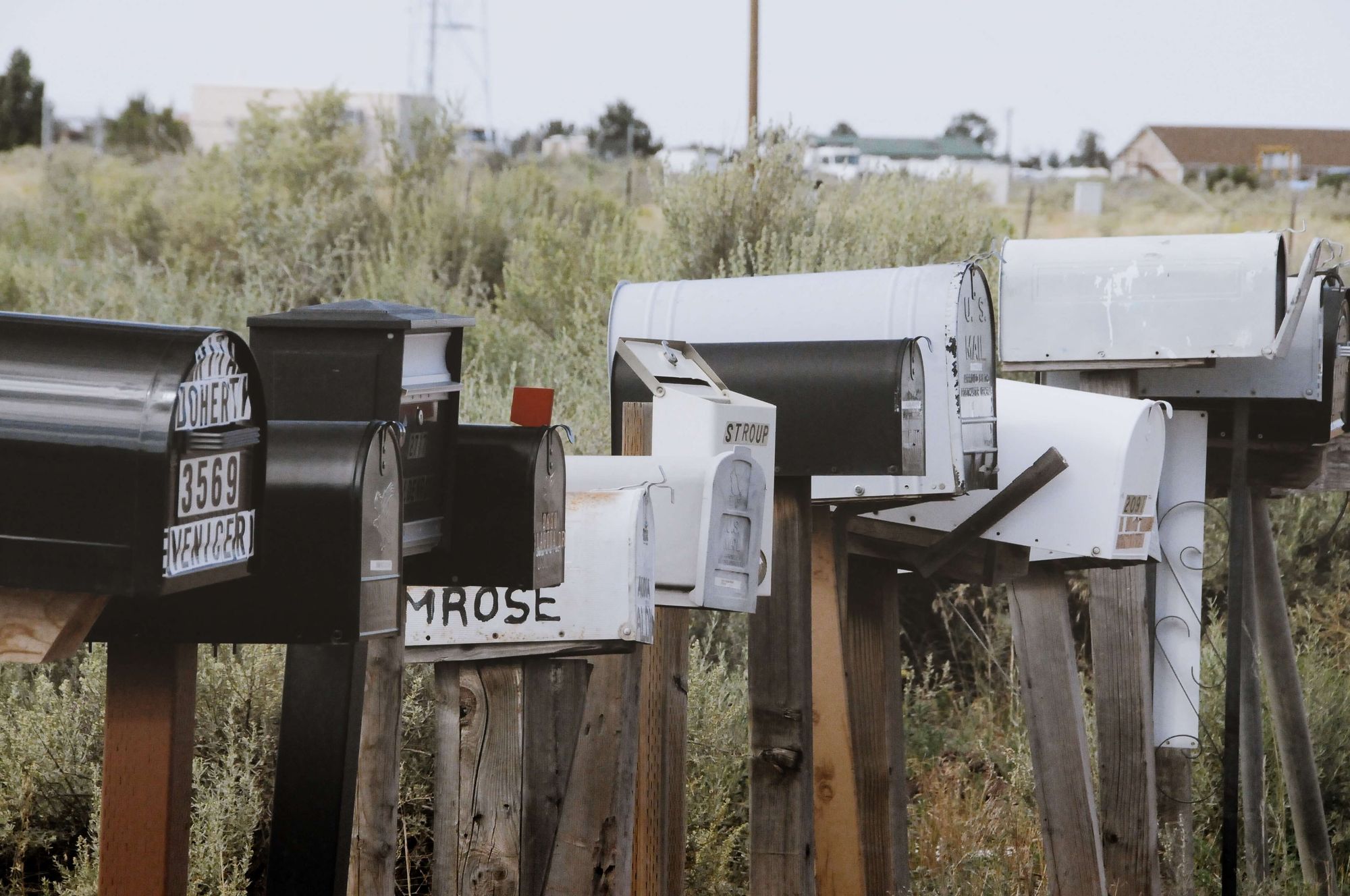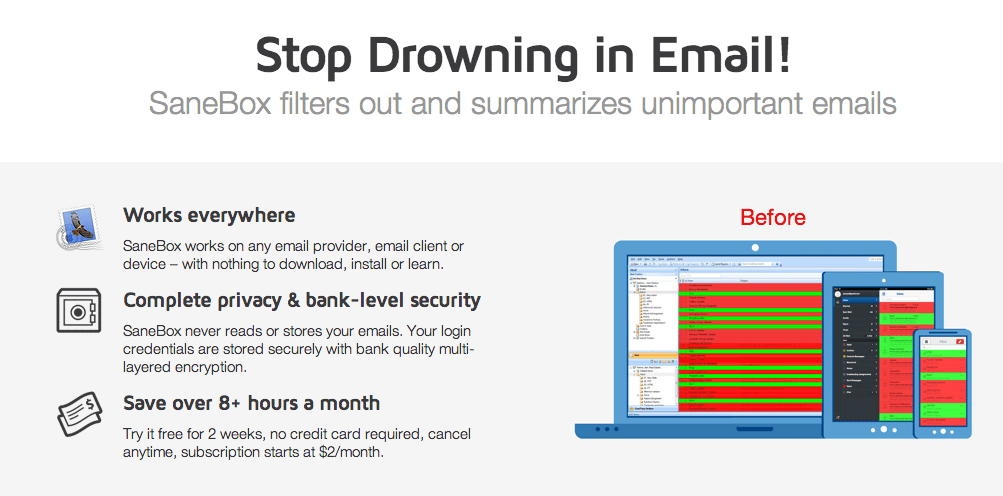One of the big things over the next couple years will be getting the computer on enough desktops that we’ll actually communicate using what’s called electronic mail – Bill Gates
It turns out that Bill Gates was more on target with this statement than he would have probably ever imagined.
Today, we send so much email that we’re almost constantly looking for new ways to organize our inboxes and keep them under control. Email has grown into such a large area of our lives and our workdays that I wanted to look at some of the advice we can apply to stay on top of email and make it more useful to us.
Keep clutter out of your inbox
1. Use a domain email address
If you’re emailing someone you want to impress (perhaps to ask advice or suggest a meeting), Ramsey the Blog Tyrant suggests using a domain email address, for instance belle@bufferapp.com, as opposed to a free address from a service like Gmail.
This can help to give the impression of professionalism and to immediately provide some context to your email—for instance, if I sent an email from belle@bufferapp, the recipient could immediately assume that the content will have something to do with Buffer.
2. Keep a throwaway email address handy
When you’re subscribing to newsletters or product updates, Eric Holter at Newfangled recommends using a free email address that’s separated from where you do your day-to-day emailing. This protects your personal or professional address from being signed up to newsletters you might not want, and keeps those more important inboxes clutter-free.
This can also help you keep spam out of your “real” inbox. The graph below is from a 2013 study of spam email rates—with that much spam getting through, we definitely want to keep it from clogging up our inboxes and wasting our time.

Make your outreach emails so good they can’t ignore you
Many people’s email addresses are publicly available if you look hard enough, and so we use email to reach out to people we want help from, or want to work with, even before we’ve met them. Email has become a common way to get in touch with people we don’t know.
In order to get the response that we want (or any response at all), we need to keep in mind some important rules for writing emails.
3. Try and give people a way out – it’ll make people want to say yes more
If you’re asking someone for a favor, possibly your best bet is to give them a way out. Making it clear that you’re aware of how busy your recipient is and ensuring that they have the option to choose whether or not to help you will go a long way to getting the response you want.
In fact, this is one of the best persuasion techniques available to us, and is backed up by psychology. The specific wording doesn’t matter, so long as you reaffirm the person’s right to make their own choice. It’s been studied extensively and works on everything from asking for charitable donations to asking people to participate in surveys:
All in all, over 22,000 people have been tested by researchers. Across all the studies it was found to double the chances that someone would say ‘yes’ to the request.
One of the best examples of this I found recently was when Gregory Ciotti emailed us and asked if we would be interested in publishing an infographic:
There was absolutely no pressure and it definitely made us more likely to publish it (which we did!).
4. Focus on including one line of context
This is particularly important if the recipient isn’t expecting this email. The Daily Muse has a couple of great example for how this tip can be helpful:
This is as relevant for first-time emails (“This is where we met”) as it is for emails to someone you work with regularly (“This email is about the next phase of that project we’re working on together”).
Depending on how well you know someone, you might also want to give them some information to remember who you are. Rand Fishkin suggests having a “clear and obvious identity that shows authenticity” in your email signature. This could include your name, title and company, and a link in case they need more information to remember how they know you.
5. If you want something, make it clear – How we got responses from Derek Sivers, Rand Fishkin and co.
A post at Brazen Careerist explains that being upfront about why you are sending an email will establish trust, which is “the foundation for all positive relationships.”
Here’s an example of how I’ve found this can work really well when we wrote a piece about the best blogging tips from experts (the way we’ve found this to work really well is to make the clear call to action bold):
6. Genuinely make the other person feel important and worth their time
Finding out personal details about the person you’re emailing isn’t hard, and yet it’s something that’s so often overlooked. This could be something you have in common found on the about page of their website, or simply a comment on some work they’ve done recently—a book or blog post they wrote that you enjoyed. This can help to give your email a more personal, conversational tone, and make you seem more likable in the process.
I’ll admit, this is easier if you already know someone a little bit. Here’s an example of how I’ve used this before with an entrepreneur called Nate Kontny who I’d interacted with a couple of times before about his blog posts and his product, Draft:

7. Focus on the timing of your emails – here is how to get it right
We’ve explored the importance of finding the best time to Tweet and post on Social Media in general before here on the Buffer blog. When it comes to email, the number studies for the best time to hit send couldn’t be any more comprehensive either.
Whilst most of them focus on marketing emails and not necessarily on 1-on-1 emails, there is still a lot of truth to take from it. For example Mailchimp suggests to send emails always after 12pm with the best times in the day being between 2-5pm to send emails:
8. Add unique character to transactional emails – CD Baby’s story of creating a viral hit with 1 welcome email
This story by Derek Sivers about his most successful customer emails is brilliant. It shows how putting in a little extra effort and adding some personality to what you write can make a big difference.
When he built his company CD baby he was at some point not at all happy with how their welcome email looked like and changed it completely to something very unique. This is the original email:
Your CD has been gently taken from our CD Baby shelves with sterilized contamination-free gloves and placed onto a satin pillow.
A team of 50 employees inspected your CD and polished it to make sure it was in the best possible condition before mailing.
Our packing specialist from Japan lit a candle and a hush fell over the crowd as he put your CD into the best gold-lined box that money can buy.
We all had a wonderful celebration afterwards and the whole party marched down the street to the post office where the entire town of Portland waved “Bon Voyage!” to your package, on its way to you, in our private CD Baby jet on this day, Friday, June 6th.
I hope you had a wonderful time shopping at CD Baby. We sure did. Your picture is on our wall as “Customer of the Year.”
We’re all exhausted but can’t wait for you to come back to CDBABY.COM!!
The success of this email was absolutely incredible Derek reports, he says that “Each one is somebody who got the email and loved it enough to post it on his website and tell all his friends. That one goofy email created thousands of new customers.”
Adding some unique character to your emails can make a massive difference.
Process your inbox and get things doneOn the other end of email, if you’re the receiving party, you might want some tips to keep your inbox from getting out of control. Here are some ideas that could help you stay on top of things.
9. Use your inbox as a to-do list
Lots of people don’t like using their inbox as a to-do list. Some people I know are really efficient at moving tasks into their task manager of choice so they can archive the emails immediately. If that doesn’t work for you, there are a couple of ways you can manage your inbox as a to-do list.
- Use the “mark as unread” option for anything that needs your attention. This means all the unread emails in your inbox are your to-do items.
- Or, archive anything that doesn’t need your attention. This means everything in your inbox is a to-do item.
Entrepreneur Nat Turner uses the archive option, so that his inbox doesn’t have thousands of emails in it, which he’d find overwhelming. But either of these methods could work.
This is how Nat explains his process for managing his inbox:
Anything that doesn’t require any attention, Archive the thread. I do this having full confidence in being able to find things later via Search… My email inbox becomes a relatively short list of items that require near-term action such as a thoughtful reply, follow-up, some other event (such as sending out a calendar invite post-scheduling, or calling someone back).
10. Enable “send and archive”
Many email clients offer an option to automatically archive email threads that you’ve replied to. This saves you the extra step of archiving if you’ve already processed and replied to an email:
11. Remember what you’ve put off
Bill Gates said in an interview a few years ago that he only got 40 or 50 emails day. I’m sure many of you are getting more than that on a daily basis! One great point he made though, which could apply to anyone who gets a lot of email, was this:
Make sure if you put something off you get back to it later.
So if you read an email and aren’t ready to respond, make sure you set up a system so that you don’t forget to return to it later. This could be a task on your to-do list, a reminder or a snooze like the iOS app Mailbox includes.
2 Best tips to stay organized and give every email a home
There are lots of different opinions about how best to utilize (or ignore) labels, filters and folders in email. Here are a couple of different ways they could be useful to you.
12. Use labels and filters together
If you’re using Gmail, you can set up filters to automatically label (and archive, if you want) particular emails. This could be receipts or order confirmations that you don’t want clogging up your inbox. It could even be a part of how you work, as it is at Stripe and here at Buffer.
13. Use your starred folder
If you add stars to your emails, most email clients will put them into a separate “starred” folder. This means if there are messages you want to return to later or follow up, you can quickly and easily set them aside by starring and archiving them—this gets them out of your inbox, and into one central folder you can return to on a regular basis.
Useful tools to help you out
There are lots of great email clients available for every platform, but there are also some lesser-known tools that can help you get a better handle on your inbox.
14. Boomerang
If you’ve used (or heard of) Mailbox’s famous snooze feature, you’ll understand Boomerang right away. It’s made to be used with Gmail’s web interface, and it gives the opportunity to remove an email from your inbox and have it return again later. Nat Turner explained on his blog how useful Boomerang is:
On any email I’m sending that I need a response for, I utilize Boomerang religiously to remind me if someone doesn’t reply in X days. This is great to use when, for example, scheduling something time sensitive. Boomerang automatically Stars the thread and moves it to your inbox when the deadline passes.
15. Unroll.me
If you subscribe to a lot of newsletters (and especially if you’re not using a throwaway email address for this purpose) then Unroll.me could be just what you need. This free service monitors your inbox for emails that look like newsletters and pulls them all out of your inbox. They’re stored away in an Unroll.me folder so you can see them if you want to, but you’ll also get a digest every day of which ones you’ve received so you can batch-read them.
One of my favorite features of this service is how easy it is to unsubscribe from email updates you no longer want. In your Unroll.me account, you can see a list of everything you’re receiving and with one click you can unsubscribe from most newsletters.
16. Batched Inbox
If you need to keep your inbox open during the day, Batched Inbox for Gmail could be really handy. It takes all of your incoming mail and keeps it out of your inbox until a time that you’ve specified. So you can keep your inbox open to read, send and reply to emails, but you won’t receive anything new until a set time.
This will give you a chance to batch read and respond to emails at a time that’s convenient for you, rather than being interrupted during the day.
17. SaneBox
Another tool to help you keep on top of your inbox is SaneBox. This one does a few different things to make your email more manageable—it helps you unsubscribe from newsletters with one click, defer emails until you’re ready to deal with them (like Boomerang) and most importantly: it filters emails that are unimportant into a separate folder, leaving your inbox free from time-wasting distractions. And you don’t even have to lift a finger—SaneBox does it all for you!
18. Rapportive
For building relationships (see points 5 and 6), Rapportive is a really useful tool. You can add it to your Gmail inbox for free and it will show you details about the contacts you email, such as their Twitter handle, LinkedIn bio, their photo and even their location. You can add comments to each person’s profile as well, so you can remember important details next time you send them an email.
It’s always tricky, but email’s the way I stay in touch with things. You always wonder what might come up, what new problem…I first find out about problems often with a piece of email. – Bill Gates
Image credits: AppRiver, Mailchimp, Beyond Startup
If you have more suggestions of useful tools or tips for managing email successfully, I’d love to hear them. You can comment below, email me or find me on Twitter at @bellebethcooper.
Try Buffer for free
180,000+ creators, small businesses, and marketers use Buffer to grow their audiences every month.
Related Articles

Learn why social media monitoring matters — and pick one of the seven tools from this list to never miss a brand mention again.

We've rounded up 26 free Instagram tools for creators, marketers, and small businesses

With the newsletters on this list, you'll be able to stay on top of all developments in social media and learn from amazing experts





